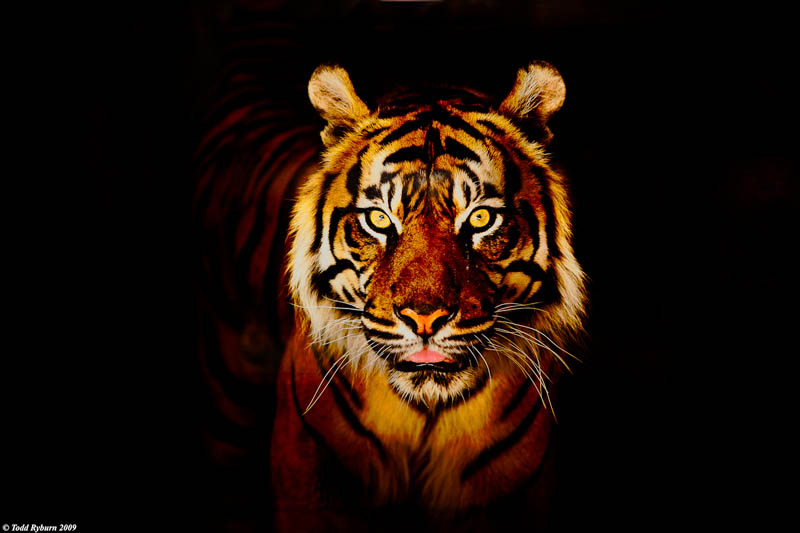
Photograph by TODD RYBURN
Beautiful, deadly and endangered. The tiger is all of these. Below you will find 15 fascinating facts and 25 incredible photographs of this magnificent animal.
2.
Photograph by MILA ZINKOVA
3.
Photograph by MIKE SEAMONS
The tiger is the largest of the four “big cats” (lions, jaguars, leopard and tigers) and is an apex predator, meaning it resides at the top of their food chain with no predators of their own.
4.
Photograph by MIKE PORTT
The larger tiger subspecies can reach up to 3.3 metres (11 ft) in total length, weighing up to 300 kilograms (660 pounds), with canines up to 4 inches long.
5.
Photograph by Randy @ TXphotoblog
6.
Photograph by RANDY DAVISON
Tigers are obligate carnivores, meaning they depend solely on the nutrients found in animal flesh.
7.
Photograph by MONIKA BETLEY
Tigers are territorial and generally solitary animals, often requiring large contiguous areas of habitat that support their prey demands. Coupled with the fact that they are indigenous to some of the more densely populated places on earth, has caused significant conflicts with humans.
8.
Photograph by KEVEN LAW
9.
Photograph by RAY HASLAM
Three of the nine subspecies of modern tiger have gone extinct, and the remaining six are classified as endangered, some critically so. The primary direct causes are habitat destruction, fragmentation, and hunting. The remaining sub-species of tigers are: Bengal, Indochinese, Malayan, Sumatran, Siberian, and South China
10.
Photograph by CATLOVERS
The largest sub-species of tiger is the Siberian Tiger, while the most numerous is the Bengal tiger.
11.
Photograph by Nachoman-au
12.
Photograph by VUHLSER
Among the big cats, only the tiger and jaguar are strong swimmers; tigers are often found bathing in ponds, lakes, and rivers. During the extreme heat of the day, they often cool off in pools. Tigers are excellent swimmers, and are able to carry prey through the water.
13.
Photograph by STEVEN J. O’BRIEN
Hybridisation among the big cats, including the tiger, was first conceptualised in the 19th century, when zoos were particularly interested in the pursuit of finding oddities to display for financial gain. Lions have been known to breed with tigers to create hybrids called ligers and tigons.
14.
Photograph by mamapajama97
Like other big cats, tigers have a white spot on the backs of their ears. These spots, called ocelli, serve a social function, by communicating the animal’s mental state to other tigers in the gloom of dense forest or in tall grass
15.
Photograph by RICHARD
There is a well-known mutation that produces the white tiger, technically known as chinchilla albinistic, an animal which is rare in the wild, but widely bred in zoos due to its popularity. Breeding of white tigers will often lead to inbreeding (as the trait is recessive).
16.
Photograph by EDGAR THISSEN
17.
Photograph by Photo505 – Online Photo Effects
Mating can occur all year round, but is generally more common between November and April. The gestation period is 16 weeks and the litter size usually consists of around 3–4 cubs of about 1 kilogram (2.2 lb) each, which are born blind and helpless.
18.
Photograph by KENDRA COWDEN
The females rear the cubs alone, sheltering them in dens such as thickets and rocky crevices. The father of the cubs generally takes no part in rearing them.
19.
Photograph by Reonis
20.
Photograph by MAHMUD KARIM
Tigers appear on many flags and coats of arms, as mascots for sporting teams, and as the national animal of several Asian nations, including India.
21.
Photograph by PAUL BUXTON
The size of a tiger’s home range mainly depends on prey abundance, and, in the case of male tigers, on access to females. A tigress may have a territory of 20 square kilometres, while the territories of males are much larger, covering 60–100 sq km. The range of a male tends to overlap those of several females.
22.
Photograph by NEIL SALONGA
India is home to the world’s largest population of tigers in the wild. According to the World Wildlife Fund, of the 3,500 tigers around the world, 1,400 are found in India.
23.
Photograph by TODD RYBURN
24.
Photograph by GAVIN BELL
ALL FACTS AND INFORMATION VIA WIKIPEDIA
25.
Photograph by BILL GRACEY
IF YOU ENJOYED THIS POST, THE SIFTER HIGHLY RECOMMENDS:
25 MAGNIFICENT PICTURES OF LIONS